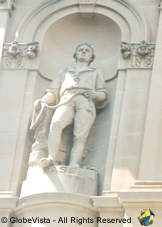George Bass statue

Public Art: George Bass statue
Sculptor: © James White
Description:
Date Unveiled: c1891
Location: The statue of George Bass is located in a niche on the Bridge Street facade of the Department of Lands Building, Bridge Street, Sydney, Australia.
So who was George Bass? : George Bass (30th January, 1771 – c 1803) was a British naval surgeon and explorer of Australia and yet another one to have vanished without trace.
Bass was born in Aswarby, Lincolnshire, England, the only child of George and Sarah Bass. He attended Boston Grammar School in Lincolnshire and later trained in medicine. In 1794 he joined the Royal Navy as a surgeon and a year later he sailed into Sydney on HMS Reliance. Onboard were also Matthew Flinders, John Hunter (second Governor of NSW), and Bennelong.
Bass, who was obviously keen to explore, brought with him a small boat which he had named the Tom Thumb. Having only been in the colony for seven weeks, Bass added a sail to his small boat and then set sail with his good friend Matthew Flinders and William Martin to explore Botany Bay and Georges River. The little expedition led to the settlement of Banks Town.
The next Tom Thumb voyage included the exploration of Lake Illawarra and the discovery of Port Hacking.
In 1797, without Flinders or the Tom Thumb, Bass again took to the sea with a crew of six in an open whaleboat in search of coal that had been reported south of Sydney by shipwreck survivors. Having successfully found the coal, his next adventure was to prove that Australia and Van Diemen’s Land (now Tasmania) was separated by water. He sailed to Cape Howe and then to Western Port Bay taking particular note of the tides and swells. He was now convinced that a strait existed.
The following year Bass and his good pal Flinders decided to prove this theory by successfully circumnavigating Van Diemen’s Land in the sloop Norfolk thus proving the existence of a strait. Bass for his part was rewarded by having the Strait named in his honour, the famous Bass Strait.
Bass was now becoming quite peeved about the small amount of pay he was receiving for his risky endeavours in Australia and began looking further afield. There were fortunes to be made in the shipping trade. In 1799, Bass boarded the Nautilus, captained by Charles Bishop, with the intent of returning to England. During the journey, which stopped at a group of Islands (Bass Islands) and Bombay, Bass not only continued charting but also learned of the great profits that could be made through trading. On arrival back to England, Bass and Bishop began working on a commercial venture together. They raised £10,000, bought the ship Venus and packed it full of goods to sell back in New South Wales. During this time Bass also fell in love and married Elizabeth Waterhouse, the sister of his former captain Henry Waterhouse.
Unfortunately, Bass and Bishop weren’t the only ones with grand ideas of selling goods in Sydney. When they arrived in Port Jackson they were horrified to discover that the market was already overstocked and their goods unsellable. With the damning sound of “debt” ringing in their ears, Bass did some fast talking and made a deal with the then Governor Philip Gidley King to sail to the South Islands to pick up some pork for the government. During the Voyage Bass did his usual charting and naming of bays and an island before buying pork and salt from the Sandwich (Hawaiian) Islands.
They eventually returned to Port Jackson with a profitable cargo of around £3000, thanks in part to the fact Captain Nicolas Baudin was in town and bought most of the pork for his French expedition.
Despite making a sizable profit he still had creditors and crew to pay. What next? Well, as luck would have it, his partner Charles Bishop fell ill and the plans to trade in New Zealand were replaced with what is speculated to be an opportunity to run cargo to South America (specifically Chile). The risk was high, but so too were the profits. At this time the Spanish and the British were at war, and thus any goods intended to be sold to the enemy would be considered contraband, and the act treason. Bass set sail on the Venus on the 5th of February, 1803. The last official sighting of Bass was at Dusky Bay in New Zealand before he, his 25 crew, and Venus vanished forever.
What Happened To Bass and His Crew?
Despite numerous reports that Bass was captured by the Spanish in Chile, no record of him or his crew has ever been found. Adding to this, all British prisoners held by the Spanish in Chile and Peru were freed in 1808 and returned to Europe.
In 1903 a search of Spanish archives by scholar Pascual de Gayangos and a search of Peruvian archives in 2003 by historian Jorge Ortiz-Sotelo found not a single mention of Bass.
Maoris in NZ claimed to have eaten the survivors of a shipwreck in the area of Foveaux Strait.
George Bass Trivia
George Bass was one of the first to describe the Australian marsupial, the wombat.